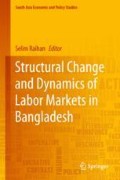Abstract
The informal economy refers to activities and income that are partially or fully outside government regulation, taxation, and observation. The main attraction of the undeclared economy is financial. This type of activity allows employers, paid employees, and the self-employed to increase their take-home earnings or reduce their costs by evading taxation and social contributions. On one hand, informal employment can provide a cushion for workers who cannot find a job in the formal sector. But on the other hand, it entails a loss in budget revenues by reducing taxes and social security contributions paid, and therefore the availability of funds to improve infrastructure and other public goods and services. It invariably leads to a high tax burden on registered labor. Like many developing countries, the urban formal sector in Bangladesh is not able to provide enough job opportunities for its growing labor force. The growing labor forces can easily find themselves in the urban informal sector for their livelihoods. Therefore, urban formal sector has gained much attention to the policymakers for its important significance in the economy. In this context, it is very important to understand the dynamics and different issues of this urban informal sector, so that better policies can be designed to address the requirements of the workers engaged in these sectors. Against this background, this study provides a detailed overview of the urban informal sector in Bangladesh and explores the factors that affect the decision of the individuals to enter into the urban informal sector.
This chapter contains excerpts from the authors’ previous publication as an op-ed in a newsletter (see: http://sanemnet.org/sanemafeefcontainer/uploads/2015/09/Thinking-Aloud_VII_N4.pdf)
Access this chapter
Tax calculation will be finalised at checkout
Purchases are for personal use only
References
Funkhouser, E. (1996). The Urban Informal Sector in Central America: Household Survey Evidence. World Development, 24(11), 1737–1751.
Hart, K. (1973). Informal Income Opportunities and Urban Employment in Ghana. Journal of Modern African Studies, 11(1), 61–89.
Hussmans, R. (2004). Measuring the informal economy: From employment in the informal sector to informal employment (Working Paper No. 53), Policy Integration, Department Geneva: Internation Labor Office, ILO.
Jayawardena, P., & Arunatilake, N. (2010). Why people choose to participate in the informal sector in Sri-Lanka. The Indian Journal of Labour Economics, 53(2).
Marcouiller, D., Castilla, V. R., & Woodruff, C. (1997). Formal Measures of the Informal-sector wage gap in Mexico, El Salvador and Peru. Economic Development and Cultural Change, 45(2), 367–392.
Reddy, M., Naidu, V., & Mohanty, M. (2001). The urban informal sector in Fiji: Results from a survey. Fijian Studies, 1(1), 127–154.
Saavedra, J., & Chong, A. (1999). Structural reform, institutions and earnings: evidence from the formal and informal sectors in urban peru. The Journal of Developments Studies, 35(4), 95–116.
Timalsina, K. P. (2011). An Urban Informal Economy: Livelihood Opportunity to Poor or Challenges for Urban Governance, Study of Street Vending Activities of Kathmandu Metropoliton City. International Journal of Policies and Good Governance, 2(2.2), Quarter II, 1–13.
Wamuthenya, W. (2010). Determinants of employment in the formal and informal sectors of the urban areas of kenya (Research Paper N0. 194). Nairobi: African Economic Research Consortium (AERC).
Author information
Authors and Affiliations
Corresponding author
Editor information
Editors and Affiliations
Rights and permissions
Copyright information
© 2018 Springer Nature Singapore Pte Ltd.
About this chapter
Cite this chapter
Raihan, S., Nafiz Ifteakhar, K.M., Angkur, M.T.N. (2018). Dynamics of Employment in the Urban Informal Sector in Bangladesh. In: Raihan, S. (eds) Structural Change and Dynamics of Labor Markets in Bangladesh. South Asia Economic and Policy Studies. Springer, Singapore. https://doi.org/10.1007/978-981-13-2071-2_6
Download citation
DOI: https://doi.org/10.1007/978-981-13-2071-2_6
Published:
Publisher Name: Springer, Singapore
Print ISBN: 978-981-13-2070-5
Online ISBN: 978-981-13-2071-2
eBook Packages: Economics and FinanceEconomics and Finance (R0)

